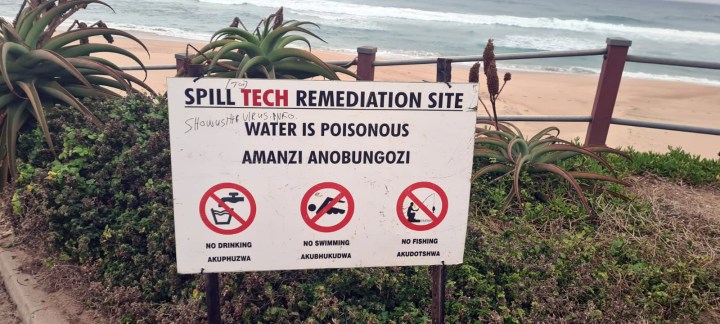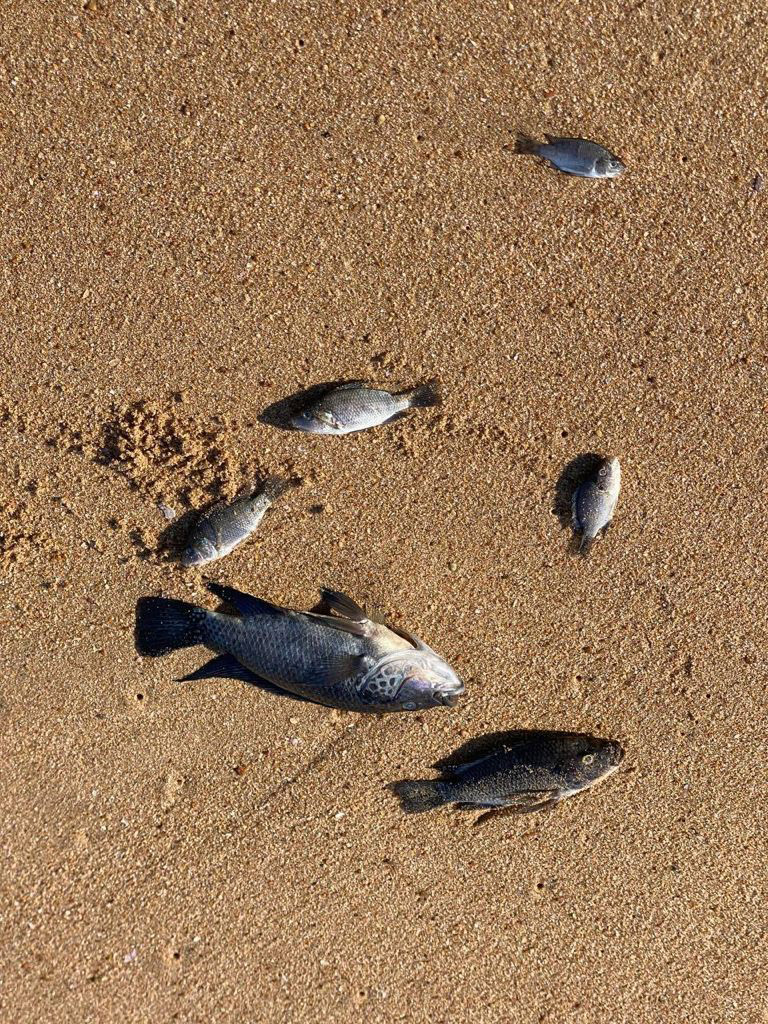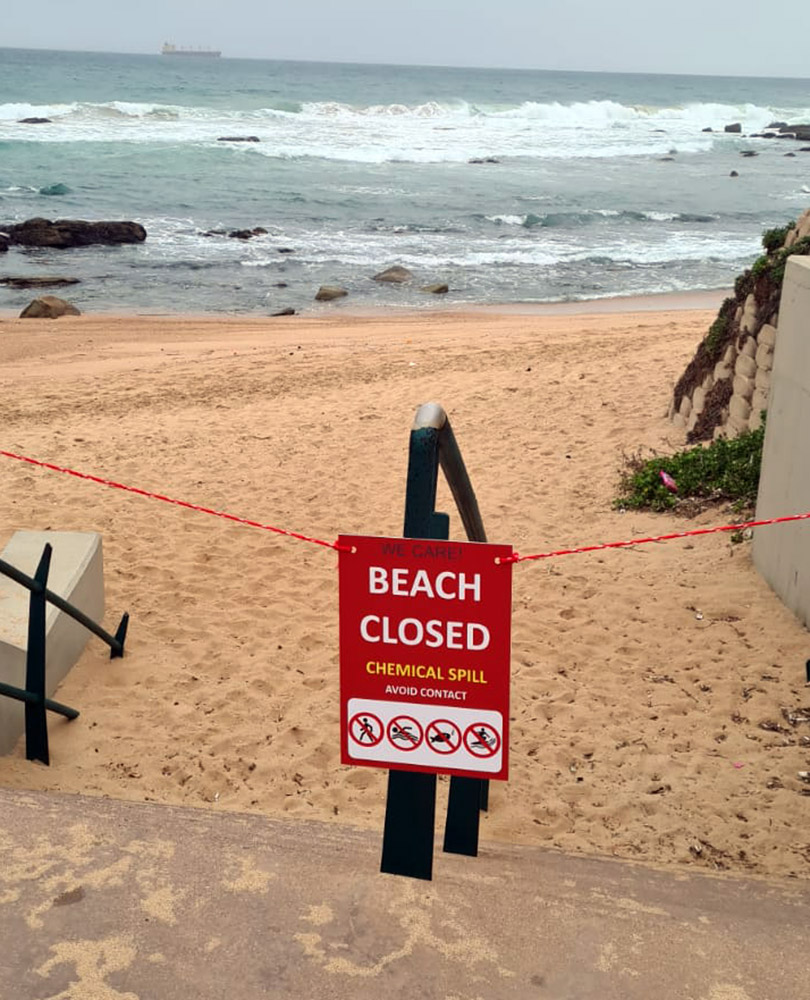AMABHUNGANE
UPL disaster: Initial tests found high levels of arsenic from Durban’s chemical spill

Eight weeks after a fire at the UPL chemical warehouse, long-awaited test results confirm that chemicals contaminated soil and rivers leaving them ‘highly toxic’. But internal letters show that even UPL’s own experts disagreed over what the results actually meant for public safety.
Eight weeks after a chemical spill closed beaches in Durban, test results from a laboratory in the United Kingdom have confirmed many people’s worst fears: the Ohlanga River, Umhlanga Lagoon and the surrounding wetland have been contaminated with highly toxic chemicals including arsenic, atrazine and bromoxynil.
The chemical spill is the result of a fire that broke out on the night of 12 July, when the UPL warehouse in Cornubia was targeted as part of the widespread unrest in KwaZulu-Natal.
The warehouse contained millions of litres of herbicides, insecticides and fungicides, including carcinogens and agricultural products that are classified as “very toxic”.
The fire and firefighting efforts resulted in a soup of toxic chemicals flowing from the warehouse into the Ohlanga River, passed the informal settlement of Blackburn village which flanks the river, and from there to the sea, leaving a horrific wave of dead fish and crustaceans in its wake.
Within days, the Ohlanga River and the Umhlanga Lagoon turned an unnaturally bright blue, likely the result of 15,000kg of blue dye stored in the UPL warehouse, although the company has refused to make public a full inventory.

Thousands of kilograms of blue dye leaked out of the UPL warehouse on 13 July, turning the Ohlanga River and its tributaries a luminous blue. A month later, clean-up crews in hazmat suits are still trying to remove the chemicals. (Photo: Mlungisi Mbele)
On Wednesday, provincial authorities provided amaBhungane with the results of the initial tests taken in the days and weeks after the fire.
The belated chemical analysis reached South Africa on 20 August, more than a month after the first tests were collected.
And while beaches were initially closed as a precaution, the results prompted the eThekwini Municipality to issue an urgent public alert, warning that 40km of beaches from Umgeni Estuary to Salt Rock would remain closed until the contamination had cleared.
The results, produced by Element Material Technology, confirm soil along the river contained “extremely high concentrations” of dangerous pesticides and also arsenic concentrations that raise “human health and environmental health concerns” — according to UPL’s own toxicologist.
Other chemicals found in relatively high concentrations, like the herbicide bromoxynil, may present a “possible risk of harm to the unborn child” — according to its official toxicological classification.
The results, which can be downloaded from amaBhungane’s website, provide the first hard evidence of which chemicals escaped from the UPL warehouse. Until now it has remained largely uncertain what danger residents around the waterways have been exposed to, especially Blackburn village which flanks the river.
Are the beaches safe?
At first blush, the results from Element paint a surprisingly rosy picture of the damage done to Durban’s beaches by the catastrophic chemical fire and resulting spillage — even quite soon after the disaster.
But letters disclosed with the results show that UPL’s own experts made starkly opposing interpretations of the data.
A review of the results by Dr Gerhard Verdoorn, the expert toxicologist contracted by UPL, made light of the low concentrations of UPL pesticides found in the affected beach sand and seawater when samples were collected at the end of July.

Two days after the UPL fire began, residents noticed dead fish washing up on Umhlanga’s beaches. At last count, 3.5 tons of dead fish had been removed as a result of the spill. (Photo: Supplied by John Wills)
For example, the deadly and widely banned atrazine was perceptible but allegedly so thinly spread that you would need “oral ingestion of an impossible quantity of 16kg beach sand per day to reach the ADI [allowable daily intake]” he wrote in a 24 August letter to UPL. The concentration found in seawater would require you to drink “667 litres of seawater per day to reach the ADI”.
Unfortunately, Verdoorn’s sanguine interpretation of the seaside results was contradicted the next day by another expert consultancy working for UPL, Apex Environmental.
After reading Verdoorn’s report, Apex wrote to UPL on 25 August arguing that the timing of the samples made the results for the beaches and seawater highly misleading.
In reality, the beaches would soon be anything but safe, it argued.
The estuary opens and closes, depending on river flow and tides, and may stop flowing into the sea for several weeks at a time. The samples were taken at the end of July when the mouth was closed. As a result, the toxic soup was accumulating inside while the chemicals on the beach and in the seawater were being diluted.
“The estuary mouth had been closed for approximately one week prior to sampling, and the results, therefore, do not represent the concentrations of chemicals during or directly after an estuary mouth opening event,” reads the Apex letter.
“The estuary water and sediment itself continues to be regarded as highly toxic…These results offer the specialist teams little confidence that the intertidal zones [the part of the beach exposed during low tide] outside of the buffer zone would be safe should the mouth re-open again (and which is predicted to occur this week).”
It appears that Verdoorn was overruled because, on 26 August, the eThekwini Municipality issued its urgent public alert announcing that the beaches would stay closed.
Apex seemingly also criticised Verdoorn’s opinion that the chemicals that reached the beach had undergone “dissipation to a point of no concern for human exposure at the date of sampling”.
“The chemical cocktail in the estuary is complex and may extend to (pose a risk of) additive and synergistic human health effects…Public health concerns must extend to the old, infirm, young, and immune-compromised, who may react unpredictably to even small concentrations of chemicals,” reads its letter to UPL.
To Verdoorn’s credit, he did point out the dangerous toxic build-up upstream from the beaches, but he did not expressly link it to potential later contamination and risk downstream.

eThekwini Municipality has closed roughly 40km of beaches in Durban in reaction to the spill. There is fierce debate, even amongst UPL’s experts, about whether it was safe to open to beaches. (Photo: Supplied by Nicole Bollman)
Is that arsenic safe?
One aspect that Verdoorn’s report dwells on is the very noticeable presence of arsenic, not only upstream but also in the otherwise “safe” beach sand and seawater.
The high levels of arsenic likely originate from the 30,000 litres of monosodium methyl arsonate (MSMA) that UPL was storing in its warehouse. MSMA is a common herbicide used on cotton but is banned in the US because it is considered carcinogenic.
He produced a more detailed analysis of the arsenic levels at the seashore for UPL which he “reverse calculated” to instead find a level of MSMA.
“The MSMA at the date of sampling posed no acute risk to people and most probably no chronic risk to people either (my personal opinion),” he summarised in his letter.
The assumption is however that the MSMA, an organic form of arsenic, will not break up to form elemental arsenic which is highly dangerous both for acute and chronic exposure.
“Elemental arsenic is acutely toxic to human beings with a median LD50 of 13 mg/kg compared the MSMA acute oral LD50 of 900 mg/kg” he noted.
LD50 is the “lethal dose” at which half of a group of exposed organisms will die from exposure. It is generally measured in milligrams of toxin per kilogram of body mass.
In other words, both rats and people can survive higher doses of MSMA. The trouble comes if and when MSMA breaks down into a more deadly form of arsenic.
According to Verdoorn: “The conditions during the fire and in the environment into which MSMA was deposited are not conducive to total reduction of MSMA to elemental arsenic. The significant difference in sediment and seawater concentration of the MSMA indicates very strongly that MSMA is still intact and has not reduced to elemental arsenic.”
Upstream the picture was more worrying: while the highest readings of MSMA found on the beach were around 20mg/kg of sample material, soil taken upstream had readings as high as 443mg/kg.

Spilltech, one of the clean-up crews hired by UPL, works to remove toxic chemicals from the river near Blackburn Village. (Photo: Mlungisi Mbele)
“This is still of human health and environmental health concerns,” Verdoorn noted.
Bear in mind that this was the picture two weeks after the fire occurred. Earlier test results from samples taken just days after the fire broke out, showed exceedingly high levels of arsenic.
Whereas the acceptable arsenic level for water used for recreational purposes is between 0.002 and 0.12 parts per million (ppm), according to the report, water samples collected downstream from the torched warehouse found over 500 ppm.
A similar picture was reflected in soil samples taken on the same day.
South Africa limits arsenic to 5.8 mg/kg in soil, substantially more than 0.0015 ppm (or mg/kg) allowed by the US Environmental Protection Agency. A soil sample taken roughly 700 metres from the warehouse in the days following the fire found concentrations of arsenic at 320 ppm (or mg/kg).
‘Extremely high concentrations’
Verdoorn’s letter highlighted 13 other chemicals of concern detected upstream from the beach.
“Since there is only one comprehensive set of analytical data available at present, I cannot make any assumptions about the reduction in the pesticide ‘load’ in the sediments and water of the other sample site, suffice to say that as expected some substances reflect in low to extremely high concentrations in the sediments.”
Among the dangerous chemicals found in very high concentrations upstream was atrazine, the herbicide that is banned in 31 countries because it “may cause damage to organs through prolonged or repeated exposure”. The UPL warehouse contained roughly 150,000 litres of atrazine-based products and another 30 tonnes in dry form.
High levels of atrazine were found in water running from the warehouse, down to where the tributary met the Ohlanga River, just before the river passes the informal settlement of Blackburn Village, home to roughly 7,000 people.
Bromoxynil, a widely-used but nonetheless “toxic” herbicide, was also found in high levels in 12 out of 13 soil samples that were taken in the second batch of tests, with the highest concentrations around the warehouse and up to 700m away along the tributary.
UPL was storing 26,000kg of raw (technical grade) bromoxynil and another 17,000 litres of bromoxynil-based products in its warehouse, according to an inventory leaked to amaBhungane.
Browse or download the leaked inventory: Here’s the full inventory of chemicals in the destroyed Cornubia warehouse.
The safety data sheets for these products warn that they present “possible risk of harm to the unborn child” and are “very toxic to aquatic organisms” and “may cause long-term adverse effects in the aquatic environment”.
In animal tests, pregnant rats that were given oral doses of bromoxynil, delivered pups with “abnormal rib formation and reduced fetal weight”. Pregnant rabbits that received slightly lower doses, delivered babies with “birth defects included changes in bone formation in the skull and hydrocephaly”, a build-up of fluid around the brain that can cause brain damage.
Soil samples taken from Blackburn Village found elevated levels of bromoxynil but not enough to match the levels that triggered birth defects in rats and rabbits.
However, these results really only tell us about the toxicity of the soil on the day the samples were taken, 16 days after the fire began. Determining what levels of bromoxynil, or any other chemical, people were exposed to in the first few days of the disaster is a different story.
Another chemical that Verdoorn’s letter highlights is picloram, a herbicide sold under the brand name Kaput. UPL was storing 34,800kg of raw picloram in its warehouse, and more than 110,000 litres of products containing picloram.
Picloram is classified as “harmful” and UPL’s safety data sheet warns that swallowing it “may cause lung damage”. Very high levels of picloram were found in all 13 soil samples as well as five water samples.
Diuron, a suspected carcinogen, was also found in high concentrations in around 12 out of the 13 soil samples, as well as several water samples. The UPL warehouse contained 60,000kg of raw diuron and diuron-based products as well as 45,000 litres of liquid diuron products.
But there were other chemicals that were missing — not because they were not present but because no one thought to test for them.

Blackburn Village is barely 1km from the torched UPL warehouse. Home to roughly 7,000 people, this informal settlement was in the direct line of fire when toxic chemicals spilled out of the warehouse on 13 July. (Photo: Mlungisi Mbele)
“I did not see any analytical results for tebuthiuron … and have no doubt that this herbicide must be in the polluted watercourses,” Verdoorn wrote towards the end of his letter.
“The other substance that I thought they should have detected in the sediments and surface water, due the high volumes that were present in the warehouse, is amicarbazone and its primary metabolite benomyl.”
These were two of the most prolific products in the UPL warehouse. The leaked inventory shows that there was more than 600,000kg of products containing tebuthiuron, a chemical classified as “very toxic to aquatic life … with long-lasting effects”, and more than 280,000 kgs of products containing amicarbazone, which is classified as “environmentally hazardous”.
“These compounds were as far as I could see not analysed for… It is very likely that these two substances are present in sediments and surface waters,” Verdoorn concluded.
But the results also throw up some surprising chemicals that cannot be directly linked back to an active ingredient in any of UPL’s products.
Surface water samples taken on 19 July, after the Ohlanga River had turned luminous blue, found exceedingly high levels of naphthalene (a hydrocarbon that smells like mothballs), 1,2,4-trimethyl benzene (a flammable liquid with a strangely sweet smell) and benzo(a)anthracene (a probable carcinogenic found in tobacco smoke).
None of these are active ingredients used in UPL products, which suggests that they may be the chimeric by-products of the fire.
Verdoorn had also previously told amaBhungane that there were concerns about possible “combination effects”.
“This means that one product may have an effect of 2 [out of 10] and another have an effect of 3 but if you combine them the effect is not 5 but 8.”
By the time the results of the late July tests came back from the UK a new round of tests had been conducted on 18 and 19 August. These results are still under lock and key but will show whether the risk for residents is waning.
At a community meeting on Saturday, Ravi Pillay, the MEC for economic affairs, tourism and environment, said that his team was analysing the latest results and the municipality may, in the coming days, relax some of the restrictions on the use of beaches. DM/OBP




















I have a serious problem with the passage and I quote, “Within days, the Ohlanga River and the Umhlanga Lagoon turned an unnaturally bright blue, likely the result of 15,000kg of blue dye stored in the UPL warehouse, although the company has refused to make public a full inventory.” Perhaps a few days in jail will open the minds and tongues, of senior management who are putting the public’s lives in danger, not to mention the possible outcomes in the future, for people, environment, animal and marine life.
I have a huge belief that these issues are taking too long to be released and for action to be taken and this all equates to, “out of sight, out of mind”, giving time for the vacuum-cleaner to eradicate the dirt.
yip, dats da SA we’ll revote into power on 01/11. So they can kill some more and call it Zuma’s fault.
We were in Ballito in late July – beaches were closed, but there were no warning signs or indications of why the beaches were closed owing to the spill. We saw plenty of people, including families with young children, on the beaches and in the water. Kwadukuza municipality has not done enough to warn beachgoers of the potential hazard.
Why was that local village not immediately relocated together with their livestock??? Frightened some local politicians will get their bums smacked over lack of ERPs etc. Meanwhile any deaths occurring will, no doubt, be blamed on COVID-19.